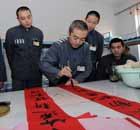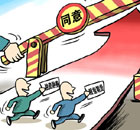Asia-Pacific
Taliban step up attacks in besieged Afghan town
(Agencies)
Updated: 2010-02-16 09:17
 |
Large Medium Small |
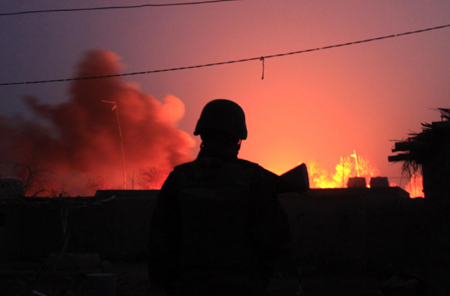 |
|
An Afghan soldier stands in front of burning gas storage set on fire by Taliban fighters in the town of Marjah in Nad Ali district of Helmand province February 14, 2010. Picture taken on February 14, 2010.[Photo/Agencies] |
MARJAH, Afghanistan: Taliban fighters stepped up counterattacks against Marines and Afghan soldiers in the militant stronghold of Marjah, slowing the allied advance to a crawl despite Afghan government claims that the insurgents are broken and on the run.
Taliban fighters appeared to be slipping under cover of darkness into compounds already deemed free of weapons and explosives, then opening fire Monday on the Marines from behind U.S. lines.
Also on Monday, NATO said five civilians were accidentally killed and two wounded by an airstrike when they were mistakenly believed to have been planting roadside bombs in Kandahar province, east of the Marjah offensive.
The airstrike happened one day after 12 people, half of them children, were killed by two U.S. missiles that struck a house on the outskirts of Marjah. Afghan officials said Monday that three Taliban fighters were in the house at the time of the attack.
On the third day of the main attack on Marjah, Afghan commanders spoke optimistically about progress in the town of about 80,000 people, the linchpin of the Taliban logistical and opium poppy smuggling network in the militant-influenced south.
Brig. Gen. Sher Mohammad Zazai, commander of Afghan troops in the south, told reporters in nearby Lashkar Gah that there had been "low resistance" in the town, adding "soon we will have Marjah cleared of enemies."
Interior Minister Hanif Atmar said many insurgent fighters had already fled Marjah, possibly heading for Pakistan.
In Marjah, however, there was little sign the Taliban were broken. Instead, small, mobile teams of insurgents repeatedly attacked U.S. and Afghan troops with rocket, rifle and rocket-propelled grenade fire. Insurgents moved close enough to the main road to fire repeatedly at columns of mine-clearing vehicles.
At midday at least six large gunbattles were raging across the town, and helicopter gunships couldn't cover all the different fighting locations.
Allied officials have reported only two coalition deaths so far _ one American and one Briton killed Saturday. There have been no reports of wounded. Afghan officials said at least 27 insurgents have been killed so far in the offensive.
Nonetheless, the harassment tactics and the huge number of roadside bombs, mines and booby traps planted throughout Marjah have succeeded in slowing the movement of allied forces through the town. After daylong skirmishes, some Marine units had barely advanced at all by sundown.
As long as the town remains unstable, NATO officials cannot move to the second phase _ restoring Afghan government control and rushing in aid and public services to win over inhabitants who have been living under Taliban rule for years.
Afghan President Hamid Karzai approved the assault on Marjah only after instructing NATO and Afghan commanders to be careful about harming civilians. "This operation has been done with that in mind," the top NATO commander, U.S. Gen. Stanley McChrystal, said Monday.
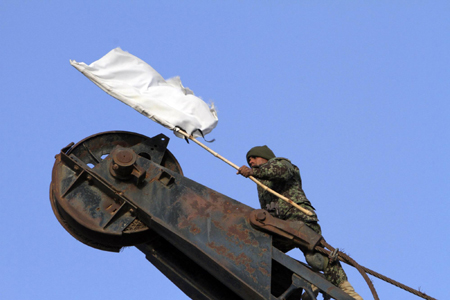 |
|
Private Aziz Watandosd, 22, of 2nd Company 1st Battalion, 201st Corp of the Afghan National Army climbs a crane to remove the Taliban's white flag before raising the Afghan national flag in the former Taliban stronghold of central Showal February 15, 2010. The area was secured by British ISAF and Afghan forces. [Photo/Agencies] |
Despite those instructions, NATO said two U.S. rockets veered off target by up to 600 yards and slammed into a home Sunday outside Marjah, killing 12 people. Six children were among the dead, a NATO military official confirmed Monday, speaking on condition of anonymity because the information had not been formally released.
In London, Britain's top military officer, Air Chief Marshal Sir Jock Stirrup, called the missile strike a "very serious setback" to efforts to win the support of local communities, who are from the same Pashtun ethnic group as the Taliban.
"This operation ... is not about battling the Taliban. It is about protecting the local population, and you don't protect them when you kill them," he said in an interview with the British Broadcasting Corp.
NATO said the Kandahar airstrike was ordered Monday after a joint NATO-Afghan patrol saw people digging along a path "and believed that the individuals" were planting a roadside bomb. When they realized their mistake,
troops flew the wounded to a NATO hospital, the statement said.
"We regret this tragic accident and offer our sympathies to the families of those killed and injured," said Maj. Gen. Michael Regner, the NATO command's deputy chief of staff for joint operations. "Our combined forces take every precaution to minimize civilian casualties, and we will investigate this incident to determine how this happened."
About 15,000 U.S., Afghan and British troops are taking part in the massive offensive around Marjah area - the largest southern town under Taliban control. The offensive is the biggest joint operation since the 2001 U.S.-led invasion of Afghanistan.
The main attack began before dawn Saturday when dozens of helicopters dropped hundreds of Marines and Afghan soldiers into the heart of the city. Ground troops began moving just before sunrise, using makeshift bridges to cross the irrigation canals ringing the town because the main bridge was so heavily mined.
Although there was only scattered resistance on the first day, Taliban fighters seem to have regrouped, using hit-and-run tactics to try to prevent the Americans and their Afghan allies from gaining full control of the area.
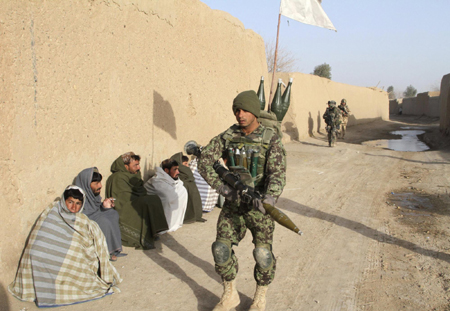 |
|
Private Aziz Watandosd, 22, of 2nd Company 1st Battalion, 201st Corp of the Afghan National Army carries the Taliban's white flag after removing it to raise the Afghan national flag in the former Taliban stronghold of central Showal February 15, 2010. The area was secured by British ISAF and Afghan forces.[Photo/Agencies] |
The Taliban snipers appeared highly skilled at concealing themselves.
"I haven't seen anything, not one person, not a muzzle flash," said Richard Knie, of Hudson, Iowa, a former Marine and retired police officer embedded with the Marines as a law enforcement professional. "And I've been looking a lot."
Troops complained that strict rules to protect civilians made it difficult to use enough firepower to stop the attacks.
"I understand the reason behind it, but it's so hard to fight a war like this," said Lance Corp. Travis Anderson, 20, from Altoona, Iowa. "They're using our rules of engagement against us," he said, adding that his platoon had repeatedly seen men dropping their guns into ditches before walking away to melt among civilians.

